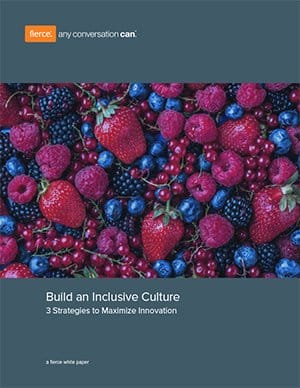You’ve probably heard it before — seek input, be inclusive, welcome perspectives, collaborate with others. But why? Where does this premise come from and why is this type of inclusion beneficial for individuals, teams, or organizations?
In a recent company meeting, we discussed the effectiveness of different learning strategies. The topic got me thinking about the similarities and differences that exist from person to person, learning or otherwise. We briefly discussed strength finders, MBTI, and other tests that help people understand themselves and others better.
Although I believe these assessments are merely tools of understanding and not a diagnosis, it made me think about the diversity of thought and how our individual traits tie into the bigger picture of an organization.
Imagine, for example, an organization made up of only ESTJ personality types (extroverted, sensing, thinking, and judging). An organization like this would be missing out on the valuable perspectives of introverts, intuitives, feelers, and perceivers, and any other combination of the eight different traits. This would inevitably limit your product or service by limiting your ability to provide a solution that has been approached and devised from “all angles.” Decisions and your overall business are limited when perspectives are limited.
Our Fierce Team Model uses the term “beach ball” to describe how perspectives occur within organizations. Each person, from every level within the organization’s hierarchy, has their own color stripe on the beach ball. Of course, it takes all the individual stripes coming together collectively to make up the beach ball.
The beach ball analogy comes from the idea that no single person holds the whole truth, but rather a mere sliver or “stripe” of it. And every stripe counts.
An article from Scientific America titled “How Diversity Makes Us Smarter” states that “decades of research by organizational scientists, psychologists, sociologists, economists, and demographers show that socially diverse groups (that is, those with a diversity of race, ethnicity, gender, and sexual orientation) are more innovative than homogeneous groups.”
Although the focus should be geared toward diversity of thought regardless of a social group, this finding illustrates that when individuals from different walks of life come together and share unique viewpoints, positive results increase.
Without diversity of thought, innovation is thwarted, initiatives may stall, and you alone cannot save your organization. You need to approach issues with a number of perspectives to be able to see the whole truth.
Barriers to Creating More Inclusion
While seeking input sounds easy enough, many organizations struggle to follow through. Here are some of the barriers that often arise.
We’re afraid our own perspective won’t be good enough.
Your perspective is valid and it matters, but it is limited by your own experience. There’s no way around this fact, and it’s true for everyone. Our egos would like us to believe that we have all the answers, or that our way is the best way, and we want to be perceived by others as competent. But there are other people to consider, including the people who your product or service will impact. It’s bigger than just you.
What we have to accept is that someone else in the room may have a better idea, and that’s ok.
We invite the wrong people to the table.
What occurs too often is that leaders will invite a select few to the critical conversations, and these “favorites” may not be the only people you need to speak with. Consider who the decision will impact, and set hierarchies aside — seek input from various levels, and actively take these alternative perspectives into account when finalizing a decision.
Deep cultural problems have yet to be addressed.
Perhaps in your organization, being inclusive isn’t the norm. Would it be unusual to host a meeting where the intention is to share perspectives? Are there silos between teams and departments? Do leaders fail to give and ask for feedback? If so, you could be facing some deep cultural issues that need some serious adjustment.
The most effective, long-term solution is leadership training, and you can get started today in shifting your organization’s current mindset by seeking input from someone on a current decision you’re facing, especially someone you may not typically involve in the process. Explain the situation fully, and ask them what they think about it.
The rewards of overcoming the barriers and creating more inclusion are worth it.
Fierce provided training for the Iowa Department of Education. The organization was looking to increase collaboration among administrators, principals, and instructional coaches. After the implementation of our team model, a greater sense of unity was created by ensuring everyone was heard. “The process prevents domination by individuals,” said Dale Lass, Principal of Roosevelt Middle School. “Everyone has time to reflect on their thoughts and suggest solutions.” Through increased collaboration and sharing of perspectives, evaluations improved, and the fabric of the organization changed for the better.
To read more on how they created a more inclusive culture, view the case study here.
If you want to form an inclusive environment where other perspectives are welcomed, the focus should be on getting curious and expanding your thinking.
Here are some actions to overcome barriers and ignite a more inclusive culture:
1. Host a Beach Ball meeting.
Even if you’ve never participated in the Fierce Team Program, you can still apply the concept of the model. Start by identifying an issue in need of resolution and invite key influencers to the meeting. Before the meeting, provide them with the issue at hand, why it matters, the ideal outcome, and what help you would like from the group.
When you need to make a decision or move a project forward, multiple heads are always better than one. I can’t tell you how many times I’ve sat in a Beach Ball meeting and thought holy cow, I never thought of that! And the action steps we take following one of these meetings is always more informed and beneficial for the organization as a whole.
2. Abandon “right and wrong.”
Sure, there are times when objectivity is needed, and data doesn’t lie. But when it comes to our approach toward the perspectives of others, especially when subjectivity plays a role, it’s important to be open by avoiding the labels of “right” or “wrong” when we invite others ideas to the table. Instead, reframe right and wrong to what “will work” or “won’t work” for the matter at hand.
Consider the following question:
Based on all of the perspectives that have been shared, what’s ultimately the best decision for the organization?
3. Practice inclusion without illusion.
Don’t just implement inclusion initiatives for the sake of best practices. Do so out of genuine curiosity and interest. Check in with yourself regarding your approach—if you don’t believe another’s input to be valid or worth hearing, chances are, they’ll be able to pick up on it and see that you’re brushing their perspective under the rug. Remind yourself that every stripe has value (regardless of organizational level) and listen with an open mind.
An added benefit to inviting diverse perspectives is that on an individual level, we feel appreciated and heard. Knowing that your own stripe is being considered, regardless of the outcome, is a good feeling.
Leaders need to leverage the strengths that vary from person to person as well as our unique contexts, preferences, and life experiences. And contributors, bring all of who you are to the conversation because your unique experience of the world is valid. Every perspective matters. We’re all moving in a direction toward a common goal in our organizations, and when everyone contributes their perspective to this goal, we can get there more efficiently, more effectively, and more successfully.

ALIGN VALUES AND BEHAVIORS IN YOUR COMPANY
Start by building an inclusive workplace culture
Tags: #Creative Block, #Rigid Thinking, #Work Relationships





